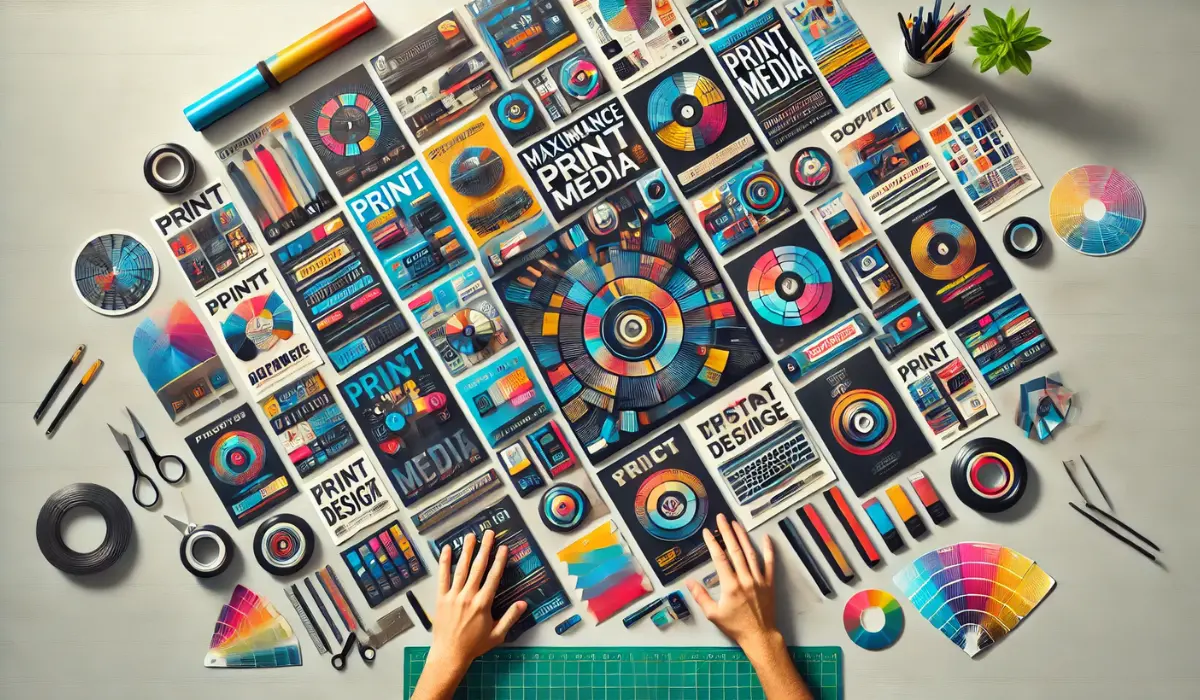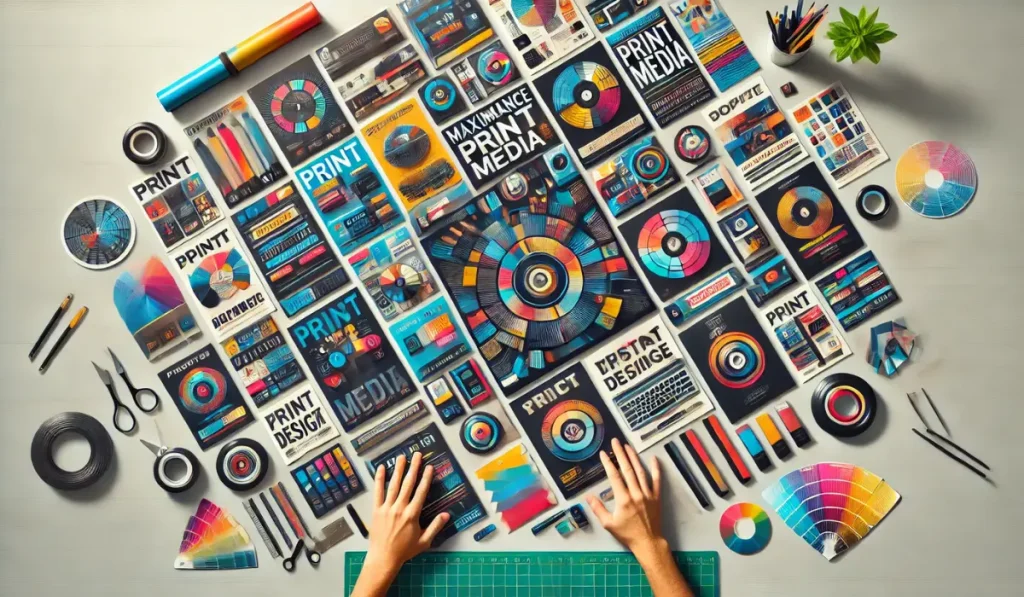In the digital age, where screens dominate communication, print media remains a powerful and effective tool for visual communication. Large-scale print materials, such as banners, posters, and billboards, offer unique advantages that digital media can’t always match. Tangibility, credibility, and the ability to create lasting impressions are some of these advantages, but maximizing the impact of print media involves more than just producing materials. It requires strategic design, execution, and integration with broader marketing efforts. By focusing on the strengths of print media—particularly large-scale formats—businesses can create visually compelling campaigns that resonate with their audience.
Understanding the Role of Print Media
Print media spans a wide variety of formats, including brochures, magazines, direct mail, banners, and posters. Large-scale print materials, such as billboards, building wraps, and exhibition displays, play a significant role in making a bold statement and capturing attention in public spaces. Understanding the purpose of each format is crucial for creating effective print campaigns.
Unlike digital media, which is often consumed passively or fleetingly, print media—especially large-scale formats—offers an immersive experience. A passerby engaging with a billboard or banner is physically interacting with the content, fostering a deeper connection with the brand. The tangibility of print materials, particularly in larger formats, enhances credibility and brand perception. However, the challenge lies in ensuring that these materials are visually engaging and convey the right message to drive action. This is where design and strategy come into play.
1. Prioritizing High-Quality Design for Large-Scale Prints
Design is one of the most critical elements in maximizing the impact of large-scale print media. Whether it’s a banner or a building wrap, the design must be visually engaging, easy to understand, and aligned with the brand’s identity. Large formats offer a broad canvas, and using this space wisely is essential for catching attention and communicating the message effectively.
a. Consistent Branding Across Sizes
Maintaining consistency across all print formats is crucial for establishing brand recognition. Large-scale banners, posters, and billboards should align with the brand’s identity by following established guidelines for logo placement, colors, and fonts. Consistency ensures that consumers can immediately recognize the brand, regardless of whether they see it in a smaller brochure or a massive outdoor banner. This strengthens the brand’s authority and helps build recognition over time.
b. Typography in Large Formats
Typography plays a significant role in large-scale print media. The right font, size, and weight ensure readability from a distance and can communicate the desired tone. Large-format prints require clear, bold fonts to stand out in busy environments. For instance, in a crowded city street where a billboard is competing with countless visual stimuli, using strong, bold typography ensures that the message is legible and impactful from afar.
c. Effective Use of Color in Banners and Posters
Color is a powerful tool in print media, especially in large-scale formats. It can evoke specific emotions and create strong associations with the brand. In larger prints, the use of contrasting colors can make banners and posters stand out in any environment. For example, using vibrant hues like red and orange can evoke excitement and urgency, perfect for promotional campaigns, while blue tones convey professionalism and trust, ideal for corporate branding. The color scheme should complement the overall message without overwhelming the viewer.
2. High-Quality Images and Graphics
Large-scale prints require high-resolution images and well-designed graphics to maintain visual quality. A grainy or pixelated image on a small flyer may be noticeable, but on a large-scale print like a banner or billboard, it becomes glaringly obvious and diminishes the professionalism of the campaign.
a. Image Quality for Large Formats
Using high-resolution images is essential for large-scale prints. The larger the banner or billboard, the more detail is required to maintain clarity. Professional photography and custom graphics should be prioritized to ensure sharpness and polish. This ensures that when a consumer looks up at a banner or poster, they see a crisp, clear image that communicates quality. Working with a company like Soyang Europe to ensure the quality of the image printed and media used.
b. Purposeful Imagery in Large-Scale Campaigns
Every image or graphic in a large-scale print should serve a clear purpose. Whether highlighting a product, evoking an emotion, or supporting the brand’s message, imagery must align with the campaign’s goals. For example, a tech company launching a new product might use an eye-catching banner featuring sleek product photography, while an outdoor adventure brand could opt for visuals that reflect rugged landscapes. The imagery must resonate with the target audience and support the overarching narrative.
3. Crafting a Clear and Compelling Message
In large-scale print media, clarity and brevity are key. Passersby often only have a few moments to take in a message, so the text must be concise, engaging, and to the point.
a. Know Your Audience
Understanding your target audience is essential for crafting the right message. Whether your banner is in a retail setting or on a billboard by the highway, the language, tone, and style must align with the audience’s preferences. A playful and informal tone might work for a lifestyle brand advertising on a festival banner, while a more formal and straightforward message could suit a corporate event display.
b. Focus on Benefits Over Features
In any print campaign, focusing on the benefits rather than just features makes the message more compelling. Consumers are more likely to engage with a message that speaks directly to their needs. For example, rather than saying, “Our product has advanced technology,” a more effective banner message might be, “Experience the future with our cutting-edge innovations.”
c. Strong Call to Action (CTA)
A strong call to action is essential for motivating viewers to take the next step. Whether it’s visiting a website, attending an event, or making a purchase, the CTA should be prominent and easy to follow. Large banners or billboards should feature clear, actionable phrases like “Shop Now,” “Visit Us Today,” or “Learn More,” directing consumers to take immediate action.
Also Read
4. Integrating Print Media with Digital Campaigns
Large-scale print media can make an even bigger impact when integrated with digital campaigns. The combination of physical and digital touchpoints creates a seamless customer experience.
a. QR Codes and Digital Links
Incorporating QR codes or short URLs into large-scale prints bridges the gap between physical and digital marketing. These tools allow consumers to easily access websites, promotions, or online resources with their smartphones. A well-placed QR code on a billboard or event banner can drive traffic to your digital platform, increasing engagement.
b. Personalization in Large-Scale Campaigns
While large-scale prints are typically used for broad messages, personalization can still play a role in targeted campaigns. For example, a poster in a specific location could include messaging that speaks directly to the local community, making the campaign feel more relevant and engaging.
5. Choosing the Right Materials and Finishes
The materials and finishes chosen for large-scale prints, such as banners and posters, play a crucial role in how they are perceived and their durability.
a. Durability for Outdoor and Indoor Campaigns
Large-scale banners and billboards often face environmental factors like wind, rain, and sunlight. Choosing durable, weather-resistant materials ensures the prints remain vibrant and intact throughout the campaign. Indoors, selecting the right finish—whether glossy or matte—can add a layer of sophistication that enhances the visual appeal.
Conclusion
Large-scale print media, such as banners, posters, and billboards, remains a valuable asset for businesses seeking to create impactful visual communication. By prioritizing high-quality design, sharp images, and clear messaging, companies can maximize the effectiveness of their large-scale campaigns. Whether integrated with digital marketing or used as standalone promotions, large-format prints offer unique opportunities to engage audiences, build brand recognition, and drive consumer action in ways that complement digital efforts.





